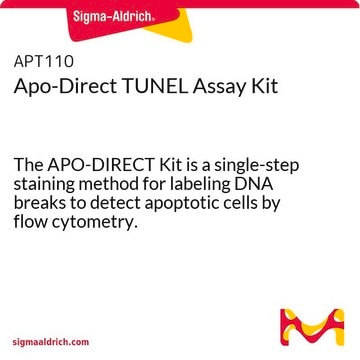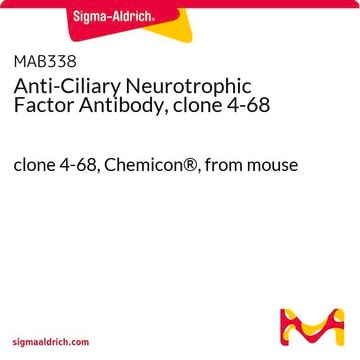12156792910
Roche
In Situ Cell Death Detection Kit, TMR red
sufficient for ≤50 tests
Synonym(s):
red, tm, in situ cell death detection kit, tm red, in situ cell death detection kit
Sign Into View Organizational & Contract Pricing
All Photos(1)
About This Item
UNSPSC Code:
12352200
Recommended Products
usage
sufficient for ≤50 tests
Quality Level
manufacturer/tradename
Roche
technique(s)
flow cytometry: suitable
storage temp.
−20°C
Related Categories
General description
Kit for the detection and quantification of apoptotic cell death on a single-cell level by flow cytometry and fluorescence microscopy, and for double labeling with fluorescein-labeled cell markers (TMR red).
Widely used methods to determine apoptosis include the analysis of the genomic DNA by agarose-gel electrophoresis and DNA fragmentation assays based on 3H-thymidine and, alternatively, 5-Bromo-2′-deoxy-uridine. The methods involve the separation of fragmented, low molecular weight DNA from unfragmented, high molecular weight DNA in a given cell population. Thus, these methods do not provide information about the fate of an individual cell in a given cell population, or particularly, in tissue sections. Alternatively, individual apoptotic cells may be microscopically recognized because of the characteristic appearance of nuclear chromatin condensation and fragmentation, but this method is subjective and limited to a relatively narrow time window when the morphological changes are at a maximum.
The hallmark of apoptosis is DNA degradation, which in early stages, is selective to the internucleosomal DNA linker regions. The DNA cleavage may yield double-stranded and single-stranded DNA breaks (nicks). Both types of breaks can be detected by labeling the free 3′-OH termini with modified nucleotides (e.g., biotin-dUTP, DIG-dUTP, fluorescein-dUTP) in an enzymatic reaction. The enzyme terminal deoxynucleotidyl transferase (TdT) catalyzes the template-independent polymerization of deoxyribonucleotides to the 3′-end of single- and double-stranded DNA. This method has also been termed TUNEL (TdT-mediated dUTP-X nick end labeling). Alternatively, free 3′-OH groups may be labeled using DNA polymerases by the template-dependent mechanism called nick translation. However, the TUNEL method is considered to be more sensitive and faster.
Sample material: Cells in suspension, cytospin and cell smear preparations, adherent cells grown on slides, and frozen and paraffin-embedded tissue sections.
Principle
The In Situ Cell Death Detection Kit, TMR red is based on the detection of single- and double-stranded DNA breaks that occur at the early stages of apoptosis.
Apoptotic cells are fixed and permeabilized. Subsequently, the cells are incubated with the TUNEL reaction mixture that contains TdT and TMR-dUTP. During this incubation period, TdT catalyzes the addition of TMR-dUTP at free 3′-OH groups in single- and double-stranded DNA. After washing, the label incorporated at the damaged sites of the DNA is visualized by flow cytometry and/or fluorescence microscopy.
The hallmark of apoptosis is DNA degradation, which in early stages, is selective to the internucleosomal DNA linker regions. The DNA cleavage may yield double-stranded and single-stranded DNA breaks (nicks). Both types of breaks can be detected by labeling the free 3′-OH termini with modified nucleotides (e.g., biotin-dUTP, DIG-dUTP, fluorescein-dUTP) in an enzymatic reaction. The enzyme terminal deoxynucleotidyl transferase (TdT) catalyzes the template-independent polymerization of deoxyribonucleotides to the 3′-end of single- and double-stranded DNA. This method has also been termed TUNEL (TdT-mediated dUTP-X nick end labeling). Alternatively, free 3′-OH groups may be labeled using DNA polymerases by the template-dependent mechanism called nick translation. However, the TUNEL method is considered to be more sensitive and faster.
Sample material: Cells in suspension, cytospin and cell smear preparations, adherent cells grown on slides, and frozen and paraffin-embedded tissue sections.
Principle
The In Situ Cell Death Detection Kit, TMR red is based on the detection of single- and double-stranded DNA breaks that occur at the early stages of apoptosis.
Apoptotic cells are fixed and permeabilized. Subsequently, the cells are incubated with the TUNEL reaction mixture that contains TdT and TMR-dUTP. During this incubation period, TdT catalyzes the addition of TMR-dUTP at free 3′-OH groups in single- and double-stranded DNA. After washing, the label incorporated at the damaged sites of the DNA is visualized by flow cytometry and/or fluorescence microscopy.
Specificity
The TUNEL reaction preferentially labels DNA strand breaks generated during apoptosis. This allows discrimination of apoptosis from necrosis and from primary DNA strand breaks induced by cytostatic drugs or irradiation.
Application
In Situ cell death detection kit, TMR red has been used in terminal deoxynucleotidyl transferase biotin–dUTP nick end labeling (TUNEL) assay. It has been used in apoptosis detection assay.
Precise, fast, and simple technique for detecting and quantitating apoptotic DNA fragmentation at the single-cell level in cells and tissues with a red fluorescent label for fluorescence microscopy and flow cytometry.
Packaging
1 kit containing 2 components.
Preparation Note
Working concentration: Enzyme concentration
The optimal enzyme concentration range from 0.5 to 5 U per assay. For a standard 50 μl PCR, we recommend using 2 U of the enzyme blend.
Working solution: Add total volume (50 μl) of Enzyme Solution to the remaining 450 μl Label Solution to obtain 500 μl TUNEL reaction mixture.
Mix well to equilibrate components.
Storage conditions (working solution): The TUNEL reaction mixture should be prepared immediately before use and should not be stored. Keep TUNEL reaction mixture on ice until use.
The optimal enzyme concentration range from 0.5 to 5 U per assay. For a standard 50 μl PCR, we recommend using 2 U of the enzyme blend.
Working solution: Add total volume (50 μl) of Enzyme Solution to the remaining 450 μl Label Solution to obtain 500 μl TUNEL reaction mixture.
Mix well to equilibrate components.
Storage conditions (working solution): The TUNEL reaction mixture should be prepared immediately before use and should not be stored. Keep TUNEL reaction mixture on ice until use.
The TUNEL reaction mixture is prepared by mixing the Enzyme Solution and the Label Solution prior to use.
Kit Components Only
Product No.
Description
- Enzyme Solution (TdT)
- Label Solution (TMR-dUTP)
Signal Word
Danger
Hazard Statements
Precautionary Statements
Hazard Classifications
Aquatic Chronic 2 - Carc. 1B Inhalation
Storage Class Code
6.1D - Non-combustible acute toxic Cat.3 / toxic hazardous materials or hazardous materials causing chronic effects
WGK
WGK 3
Flash Point(F)
does not flash
Flash Point(C)
does not flash
Choose from one of the most recent versions:
Already Own This Product?
Find documentation for the products that you have recently purchased in the Document Library.
Customers Also Viewed
Antioxidants rescue photoreceptors in rd1 mice: Relationship with thiol metabolism.
Miranda M, et al.
Free Radical Biology & Medicine, 48(2), 216-222 (2010)
Different toxicity of cadmium telluride, silicon, and carbon nanomaterials against hemocytes in silkworm, Bombyx mori.
Li K L, et al.
Royal Society of Chemistry Advances, 7(79), 50317-50327 (2017)
Mesenchymal stromal cells ameliorate oxidative stress-induced islet endothelium apoptosis and functional impairment via Wnt4-?-catenin signaling.
Wang L, et al.
Stem Cell Research & Therapy, 8(1), 188-188 (2017)
Alan C Jackson et al.
Journal of virology, 84(9), 4697-4705 (2010-02-26)
Rabies virus infection of dorsal root ganglia (DRG) was studied in vitro with cultured adult mouse DRG neurons. Recent in vivo studies of transgenic mice that express the yellow fluorescent protein indicate that neuronal process degeneration, involving both dendrites and
A novel, low-volume method for organ culture of embryonic kidneys that allows development of cortico-medullary anatomical organization.
Sebinger D D, et al.
PLoS ONE, 5(5), e10550-e10550 (2010)
Our team of scientists has experience in all areas of research including Life Science, Material Science, Chemical Synthesis, Chromatography, Analytical and many others.
Contact Technical Service










